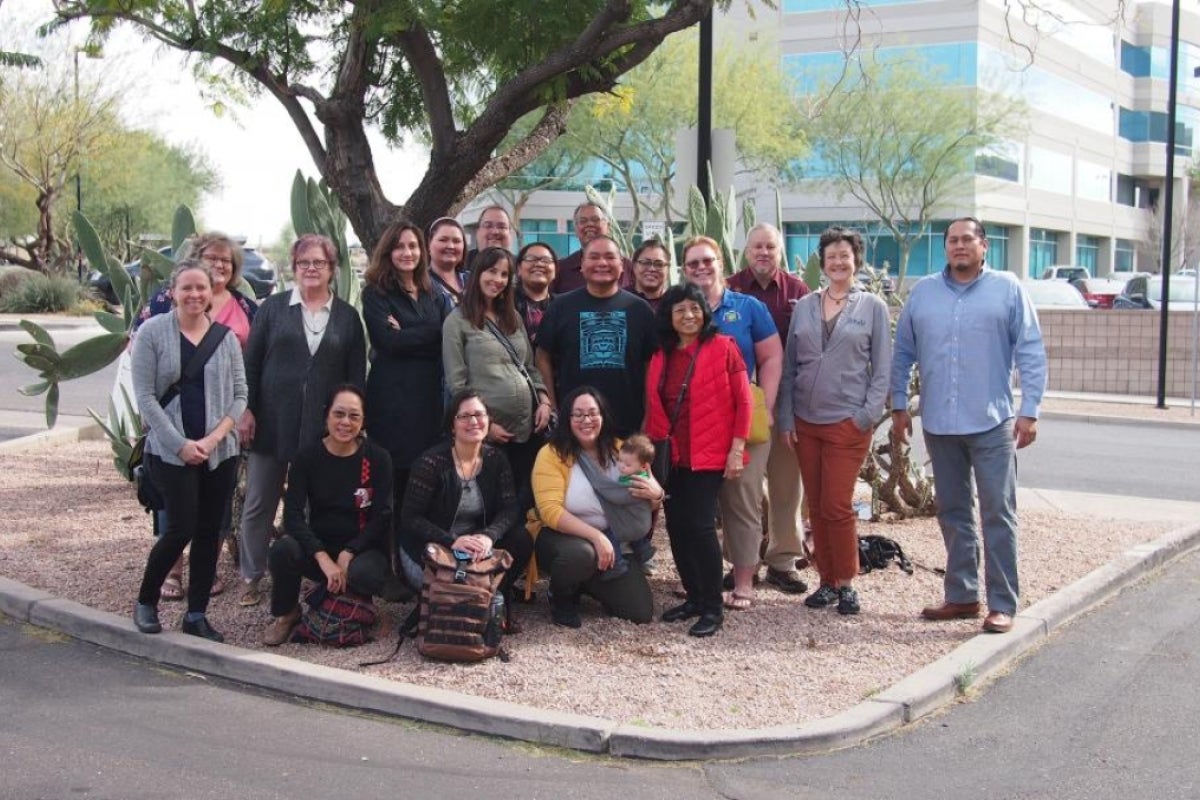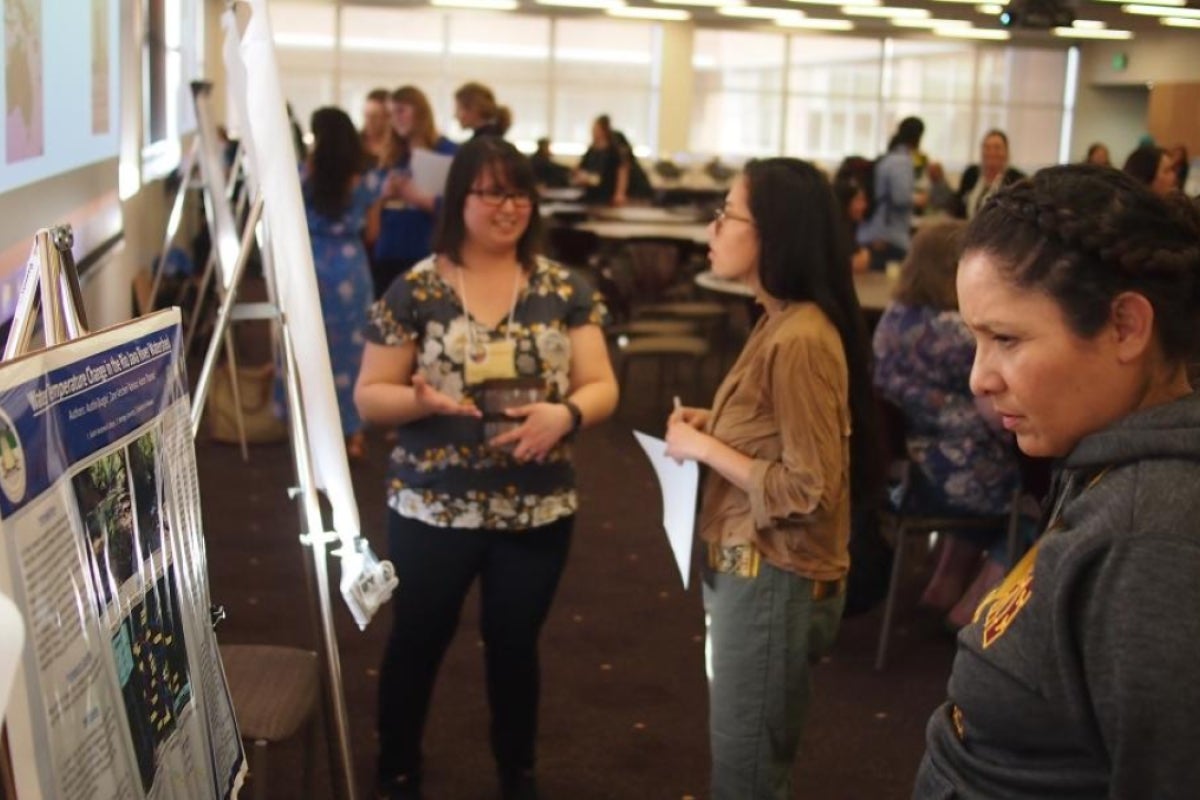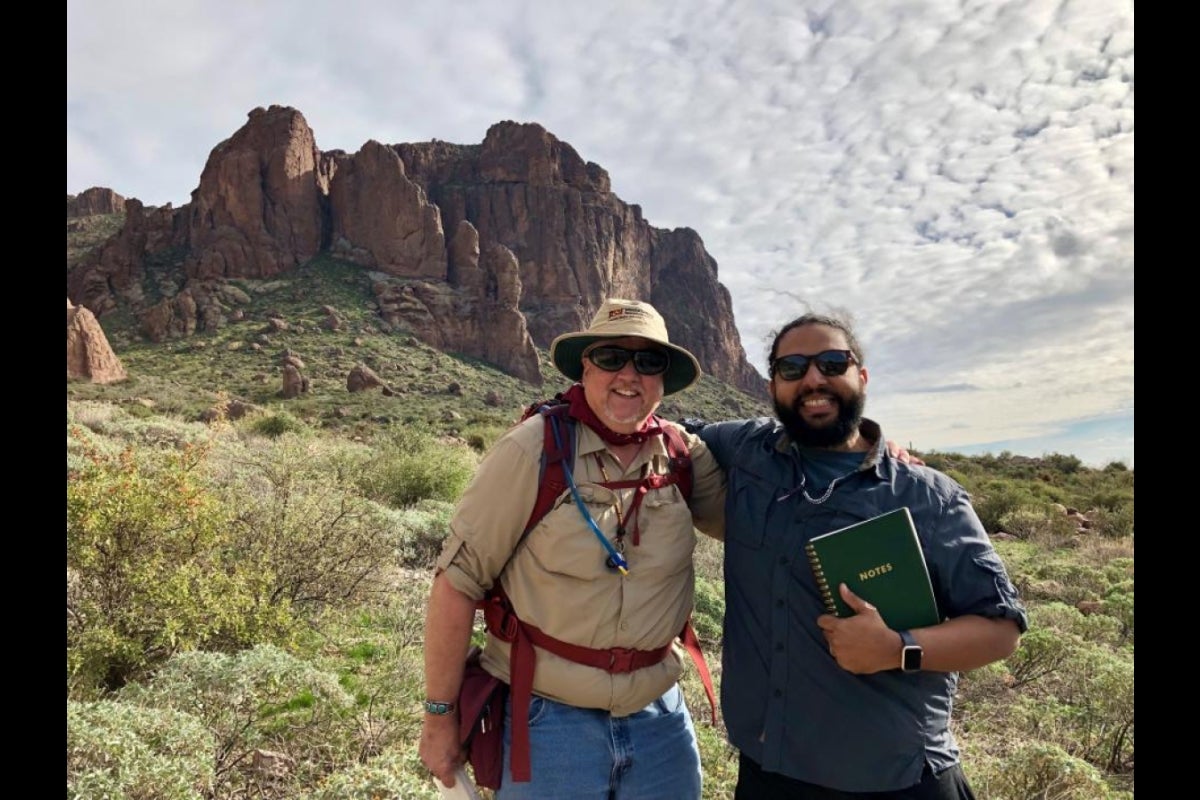Geoscience Alliance national conference inspires Native American students to pursue careers in the geosciences

Geology Professor Steven Semken of the School of Earth and Space Exploration leads a geology field trip to the Superstition Mountains with Geoscience Alliance conference participants.
Earlier this month, Arizona State University hosted the Geoscience Alliance, the nation's leading organization devoted to promoting geoscience studies and careers for Native American, Alaska Native, Native Hawaiian and other indigenous students.
“The Geoscience Alliance has been important for many years for its unique and far-ranging mission of mentoring and supporting Native American and other indigenous students and professionals in the geosciences,” said ASU School of Earth and Space Exploration Professor and geologist Steven Semken, who served as host for the conference.
“More recently, it has further grown in importance by catalyzing research and education involving indigenous geoscientific knowledge and its applications — work that is primarily led by indigenous geoscientists themselves.”
The alliance has long had an active presence at annual meetings of much larger professional organizations like the American Geophysical Union and the Geological Society of America, but its own national conference, held every few years, has the greatest impact on the stakeholder community overall. This year’s conference included 160 attendees for the three-day conference, which included workshops, breakout sessions, invited speakers and a poster session.
Ángel Garcia, who earned his PhD in geosciences from ASU earlier this year and is currently a visiting assistant professor at James Madison University in Virginia, was one of the conference’s returning attendees and is also on the conference planning committee.
Garcia first attended the Geoscience Alliance in 2015 when he was a graduate student at ASU. He learned about the conference from SemkenSemken is also a senior sustainability scientist in the Julie Ann Wrigley Global Institute of Sustainability, and a faculty affiliate of the Center for Education through Exploration and the Global Drylands Center at ASU., who suggested that it would be a good way to develop networks in the geosciences with people who were interested in multicultural topics and indigenous cultures.
“People from tribal lands have a strong connection to places,” said Garcia, who is Puerto Rican and Dominican. “We might first describe what tribe we are from, but then refer to a specific place within our tribal lands where we grew up and have family. Connections to those places go back generations for us.”
For Garcia and other participants, one of the best parts of the conference is making connections, networking with other scientists and meeting other students in the geosciences.
“These conferences give us an opportunity to learn from people with a similar culture and background,” said Garcia.
“At the Geoscience Alliance, I felt included right from the start. Now every time I see this group of people at other conferences we identify ourselves as members of the alliance, both as students and professionals.”
Since the first conference, the alliance has adopted the practice of “talking circles” from Native American ceremonies.
“We develop questions, break up into small groups and make sure each person gets a chance to talk,” explained Diana Dalbotten, who is on the alliance conference planning committee and is a diversity director at the University of Minnesota. “We have developed this to make our conference more participatory and to respect the idea that everyone is there to teach and everyone is there to learn.”
Conference attendees were also invited on several diverse field-trip opportunities related to different aspects of the geosciences, including a trip to the Superstition Mountains, the Heard Museum and Biosphere 2.
On the last night of the conference, attendees were asked to participate in a “science pop-up night” where everyone could spend three minutes talking about their projects and research. This event was so popular that even though it was the last day of the conference, it went well into the night.
“It’s important for ASU to host events that focus on local communities in Arizona and especially indigenous communities in the Southwest,” said Garcia. “Giving teachers, researchers, professors and students the opportunity to share knowledge and connection to the land shows that ASU embraces diversity.”
The conference organizers, including Semken and Garcia, hope that participants will seek more collaboration with each other in the future as a result of this conference. Garcia, for example, is working with two other researchers he met through the alliance on a National Science Foundation proposal to study the geology of caves in the Caribbean.
They also hope to continue to offer travel awards to the conference.
“Some of us come from places that are not financially stable, making conferences like this out of reach,” said Garcia. “But thanks to sponsors like the National Science Foundation, the alliance is able to provide the opportunity to those who otherwise would not be able to go.”
Previous conferences were held in the northern Midwest, the northern Rocky Mountains and the Pacific Northwest.
“It was an honor for ASU to host this most recent conference in Phoenix and Tempe,” said Semken. “I think that the alliance members enjoyed their visit to our campus and their time in the warm desert sun.”
Semken is grateful for the support given to this endeavor by many colleagues in the School of Earth and Space Exploration; the ASU President's Special Advisor for American Indian Initiatives Bryan Brayboy; ASU Vice President for Tribal Relations Jacob Moore and his staff; and to ASU alumna (and a former graduate student of Semken’s) Nievita Bueno Watts, who is the co-director of the Geoscience Alliance.
The Geoscience Alliance is a national alliance of individuals committed to broadening participation of Native Americans in the geosciences. Its members are tribal colleges, universities, research centers, Native elders and community members, students and educators.
The alliance’s goals include creating new collaborations in support of geoscience education for Native American students, establishing a new research agenda aimed at closing gaps in our knowledge on barriers and best practices related to Native American participation in the geosciences, increasing participation by Native Americans in setting the national research agenda on issues in the geosciences, providing a forum to communicate educational opportunities for Native American students in geoscience programs, and understanding and respecting indigenous traditional knowledge.
The Geoscience Alliance conferences are made possible through the generous and ongoing support of the National Science Foundation and the National Aeronautics and Space Administration.
More Science and technology

Indigenous geneticists build unprecedented research community at ASU
When Krystal Tsosie (Diné) was an undergraduate at Arizona State University, there were no Indigenous faculty she could look to…

Pioneering professor of cultural evolution pens essays for leading academic journals
When Robert Boyd wrote his 1985 book “Culture and the Evolutionary Process,” cultural evolution was not considered a true…

Lucy's lasting legacy: Donald Johanson reflects on the discovery of a lifetime
Fifty years ago, in the dusty hills of Hadar, Ethiopia, a young paleoanthropologist, Donald Johanson, discovered what would…


